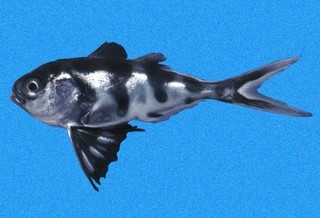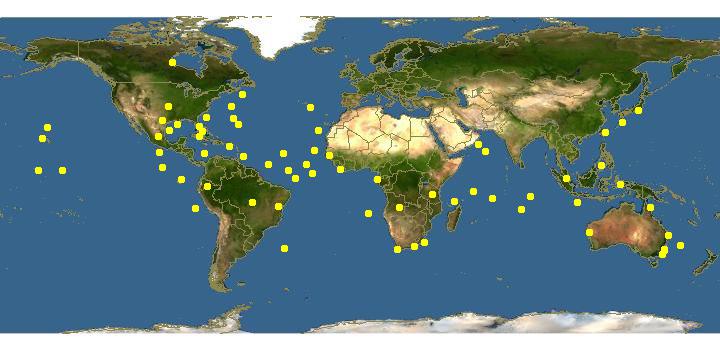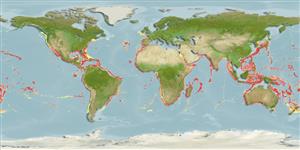|
| Links |
We parsed the following live from the Web into this page. Such content is managed by its original site and not cached on Discover Life. Please send feedback and corrections directly to the source. See original regarding copyrights and terms of use.
- Australian Faunal Directory
- FishBase
|
|
espa˝ol |
|
|
Overview |
Main identification features
- elongate
- d: origin behind pectoral base
- scales before eyes
- tongue: without teeth
- pelvic origin before/under pectoral base
- juveniles: pelvics very large
Man-of-war fish
Dorsal rays IX-XII + I, 24-28, origin of 1st dorsal behind pectoral base; anal rays I or II, 24-29; pectoral rays 19-24; pelvic fins of juvenile greatly enlarged, origin under or before pectoral base; gill rakers on first arch 8 + 15 -19; scales on head to before eye; body elongate; tongue without teeth.
Juveniles silvery with black bars and spots, pelvic fins black with white blotches; adults uniformly dark brown.
Size: reaches 40 cm.
Inhabits surface layers of the high seas; young are associated with drifting Man-of-War siphonophores (Physalia).
Depth: 0-20 m.
Worldwide in warm temperate and tropical seas. The tip of Baja California to the eastern Gulf of California to Peruand the oceanic islands.
Attributes
Abundance: Common.
Cites: Not listed.
Climate Zone: North Temperate (Californian Province &/or Northern Gulf of California); Northern Subtropical (Cortez Province + Sinaloan Gap); Northern Tropical (Mexican Province to Nicaragua + Revillagigedos); Equatorial (Costa Rica to Ecuador + Galapagos, Clipperton, Cocos, Malpelo).
Depth Range Max: 20 m.
Depth Range Min: 0 m.
Diet: pelagic jellyfish/ctenophores.
Eastern Pacific Range: Northern limit=29; Southern limit=-4; Western limit=-115; Eastern limit=-78; Latitudinal range=33; Longitudinal range=37.
Egg Type: Pelagic; Pelagic larva.
Feeding Group: Carnivore; Planktivore.
FishBase Habitat: Demersal.
Global Endemism: Circumtropical ( Indian + Pacific + Atlantic Oceans); East Pacific + Atlantic (East +/or West); Transisthmian (East Pacific + Atlantic of Central America); East Pacific + all Atlantic (East+West); All Pacific (West + Central + East); TEP non-endemic; "Transpacific" (East + Central &/or West Pacific); All species.
Habitat: Jellyfish; Water column.
Inshore Offshore: Offshore; Offshore Only.
IUCN Red List: Not evaluated / Listed.
Length Max: 40 cm.
Regional Endemism: Island (s); Continent; Continent + Island (s); Tropical Eastern Pacific (TEP) non-endemic; Eastern Pacific non-endemic; All species.
Residency: Resident.
Salinity: Marine; Marine Only.
Water Column Position: Mid Water; Near Surface; Surface; Water column only;
|
|
|
Names | |
|
|
|
Links to other sites | |
|
|
|
References |
- Ahlstrom , E. H. , Butler , J. L..and Sumida, B. Y., 1976., Pelagic stromateoid fishes (Pisces, Perciformes) of the eastern Pacific: Kinds, distributions and early life histories and observations on five of these from the northwest Atlantic., Bull. Mar. Sci., 26:285-402.
- Allen , G.R. and Robertson, D.R., 1994., Fishes of the Tropical Eastern Pacific., Crawford House Press Pty Ltd:1-332.
- Findley, L.T., Hendrickx, M.E., Brusca, R.C., van der Heiden, A.M., Hastings, P.A., Torre, J., 2003., Diversidad de la Macrofauna Marina del Golfo de California, Mexico., CD-ROM versiˇn 1.0. Projecto de la Macrofauna del Golfo .á Derechos reservados de los autores y Conservaciˇn Internacional.
- Fischer , W. , Krup , F. , Schneider , W. , Sommer , C. , Carpenter , K. E. and Niem, V. H., 1995., Guia FAO para la Identificacion de Especies de para los fines de la Pesca. Pacifico Centro-Oriental. Volumen II. Vertebrados - Parte 1., FAO2:647-1200.
- Fischer , W. , Krup , F. , Schneider , W. , Sommer , C. , Carpenter , K. E. and Niem, V. H., 1995., Guia FAO para la Identificacion de Especies de para los fines de la Pesca. Pacifico Centro-Oriental. Volumen III. Vertebrados - Parte 2., FAO3:1201-1813.
- Gmelin, J. F., 1789., Caroli a LinnÚ ... Systema Naturae per regna tria naturae, secundum classes, ordines, genera, species; cum characteribus, differentiis, synonymis, locis. Editio decimo tertia, aucta, reformata. 3 vols. in 9 parts. Lipsiae, 1788-93., Systema Naturae LinnÚ, 1:1033-1516.
- Grove , J.S. and Lavenberg, R. J., 1997., The fishes of the Galßpagos islands., Stanford University Press:863 pp.
- Kendall , W.C. and Radcliffe, L., 1912., The shore fishes. Reports on the scientific results of the expedition to the eastern tropical Pacific, ... by the U.S. Fish Commission steamer ALBATROSS, from October, 1904, to March, 1905, Lieut. Commander L.M. Garret, U.S.N., Commanding. XXV., Mem. Mus. Comp. Zool., 35(3):75-171.
- Love, M.S., Mecklenburg, C.W., Mecklenburg, T.A., Thorsteinson, L.K., 2005., es of the West Coast and Alaska: a checklist of North Pacific and Artic Ocena species from Baja California to the Alaska-Yukon border., U.S. Department of the Interior, U.S. Geological Survey, Biological Resources Division, 288pp.
- Meek , S.E. and Hildebrand, S.F., 1925., The marine fishes of Panama. Part II., Field Mus. Nat. Hist., Zool. Ser. Publ., XV:331-707.
- Van der Heiden , A. M. and Findley, L. T., 1988., Lista de los peces marinos del sur de Sinaloa, MÚxico., Anales del Centro de Ciencias del Mar y Limnologia de la Universidad Autonoma Nacional de Mexico, 15:209-224.
|
|
|
Acknowledgements | |
I thank Ashley MacDonald and John Pickering, University of Georgia, for technical support in building this page.
|
|
| Supported by | |
|
Following modified from Australian Faunal Directory
|
Top | See original
| &pull 20q v5.145 20180528: Error 301 Moved Permanently http://biodiversity.org.au/afd/taxa/5d024def-b149-478b-8e87-6ccc0d69c7fa/ |
|
Following modified from FishBase
|
Top | See original
http://www.fishbase.org/Summary/speciesSummary.php?genusname=Nomeus&speciesname=gronovii ---> http://fishbase.de/Summary/speciesSummary.php?genusname=Nomeus&speciesname=gronovii
http://fishbase.de/Summary/speciesSummary.php?genusname=Nomeus&speciesname=gronovii ---> https://fishbase.de/Summary/speciesSummary.php?genusname=Nomeus&speciesname=gronovii
https://fishbase.de/Summary/speciesSummary.php?genusname=Nomeus&speciesname=gronovii ---> http://fishbase.de/summary/Nomeus-gronovii.html
http://fishbase.de/summary/Nomeus-gronovii.html ---> https://fishbase.de/summary/Nomeus-gronovii.html
Nomeus gronovii, Man-of-war fish : fisheries

You can
sponsor
this page
Common name (e.g. trout)
Genus + Species (e.g. Gadus morhua)
-

-
About this page
-
Languages
-
User feedbacks
-
Citation
-
Uploads
-
Related species
-


 Man-of-war fish
Add your observation in
Fish Watcher
Upload your
photos
and
videos
Man-of-war fish
Add your observation in
Fish Watcher
Upload your
photos
and
videos
Pictures
|
Google image
 Nomeus gronovii
Nomeus gronovii
Picture by
O'Donnell, P.
Teleostei (teleosts) >
Scombriformes
(Mackerels) >
Nomeidae
(Driftfishes)
Etymology:
Nomeus:
Greek, nomeys, -eos = shepherd (Ref.
45335
)
.
More on author:
Gmelin
.
Environment: milieu / climate zone / depth range / distribution range
Ecology
Marine; demersal; depth range 200 - 1000 m (Ref.
58302
). Subtropical; 52°N - 45°S
Western Atlantic: Newfoundland, Canada and northern Gulf of Mexico to Brazil (Ref.
7251
). Eastern Atlantic: north-west Africa and the Canary Islands (Ref.
4777
); also S├úo Tom├ę Island (Ref.
34088
). Not recorded from the Mediterranean and most of the eastern Atlantic (Ref.
9834
). Indian and Pacific: widely distributed.
Size / Weight / Age
Maturity: L
m
?
range ? - ? cm
Max length : 39.0 cm TL male/unsexed; (Ref.
4412
)
Dorsal
spines
(total): 9 - 13;
Dorsal
soft rays
(total): 24-28;
Anal
spines
: 1-2;
Anal
soft rays
: 24 - 29;
Vertebrae
: 41. Juveniles whitish or silvery with dark blue mottlings; pelvic fins black (Ref.
4412
). Dark blue above, side silvery with patches of dark blue. Pelvic fin with inner rays joined to abdomen by membrane for its entire length (Ref.
26938
).
Found offshore in warm waters. Juveniles pelagic in coastal and offshore waters down to at least 30 m, but adults possibly demersal in deep water (Ref.
9563
). Occur in association with floating Portuguese man-of-war,
Physalia
, feeding on its tentacles and gonads and may drift with it into shore waters with proper wind conditions (Ref.
4777
). Probably also feed on other soft-bodied jellyfish as well as on zooplankton (Ref.4777).
Life cycle and mating behavior
Maturity
|
Reproduction
|
Spawning
|
Eggs
|
Fecundity
|
Larvae
Haedrich, R.L.
, 1986. Nomeidae. p. 1183-1188. In P.J.P. Whitehead, M.-L. Bauchot, J.-C. Hureau, J. Nielsen and E. Tortonese (eds.) Fishes of the North-eastern Atlantic and the Mediterranean. UNESCO, Paris. Vol. 3. (Ref.
4777
)
IUCN Red List Status (Ref.
130435
)
Least Concern (LC)
; Date assessed:
29 January 2013
CITES
Not Evaluated
Not Evaluated
Threat to humans
Harmless
Human uses
Fisheries: minor commercial
FAO - Publication:
search
|
FishSource
|
More information
Countries
FAO areas
Ecosystems
Occurrences
Introductions
Stocks
Ecology
Diet
Food items
Food consumption
Ration
Common names
Synonyms
Metabolism
Predators
Ecotoxicology
Reproduction
Maturity
Spawning
Spawning aggregation
Fecundity
Eggs
Egg development
Age/Size
Growth
Length-weight
Length-length
Length-frequencies
Morphometrics
Morphology
Larvae
Larval dynamics
Recruitment
Abundance
BRUVS
References
Aquaculture
Aquaculture profile
Strains
Genetics
Electrophoreses
Heritability
Diseases
Processing
Nutrients
Mass conversion
Collaborators
Pictures
Stamps, Coins Misc.
Sounds
Ciguatera
Speed
Swim. type
Gill area
Otoliths
Brains
Vision
Tools
E-book
|
Field guide
|
Identification keys
|
Length-frequency wizard
|
Life-history tool
|
Point map
|
Classification Tree
|
Catch-MSY
|
Special reports
Check for Aquarium maintenance
|
Check for Species Fact Sheets
|
Check for Aquaculture Fact Sheets
Download XML
Summary page
|
Point data
|
Common names
|
Photos
Internet sources
AFORO (otoliths) |
Aquatic Commons
|
BHL
|
Cloffa
|
BOLDSystems
|
Websites from users
|
Check FishWatcher
|
CISTI
|
Catalog of Fishes
:
genus
,
species
|
DiscoverLife
|
ECOTOX
| FAO - Publication:
search
|
Faunafri
| Fishipedia |
Fishtrace
| GenBank:
genome
,
nucleotide
|
GloBI
|
Google Books
|
Google Scholar
|
Google
| IGFA World Record |
MitoFish
|
National databases
|
Otolith Atlas of Taiwan Fishes
|
PubMed
| Reef Life Survey | Socotra Atlas |
Tree of Life
| Wikipedia:
Go
,
Search
| World Records Freshwater Fishing |
Zoological Record
Estimates based on models
Preferred temperature (Ref.
123201
): 7.7 - 15.4, mean 10.4 °C (based on 658 cells).
Phylogenetic diversity index (Ref.
82804
): PD
50
= 1.0000 [Uniqueness, from 0.5 = low to 2.0 = high].
Bayesian length-weight: a=0.00977 (0.00420 - 0.02273), b=3.09 (2.88 - 3.30), in cm total length, based on LWR estimates for this (Sub)family-body shape (Ref.
93245
).
Trophic level (Ref.
69278
): 3.7 ±0.38 se; based on food items.
Resilience (Ref.
120179
): High, minimum population doubling time less than 15 months (Preliminary K or Fecundity.).
Fishing Vulnerability (Ref.
59153
): Low to moderate vulnerability (29 of 100).
Price category (Ref.
80766
):
Unknown
.
Back to Search
Random Species
Back to Top
Accessed through:
Not available
FishBase mirror site :
localhost
Page last modified by :
mrius-barile
- 20 July 2016
Fatal error
: Uncaught ArgumentCountError: Too few arguments to function checkEcotox(), 1 passed in /var/www/html/summary/SpeciesSummary.php on line 2304 and exactly 3 expected in /var/www/html/includes/speciessummary.lib.php:2580 Stack trace: #0 /var/www/html/summary/SpeciesSummary.php(2304): checkEcotox() #1 {main} thrown in
/var/www/html/includes/speciessummary.lib.php
on line
2580
|
Updated: 2024-04-23 16:29:13 gmt
|







